When your mower contains old lousy gas, it will keep stalling. So it is recommended to empty the tank after every mowing session. But what if you don’t empty it or forget to do it?
To start the mower with old gas:
- Drain the remaining gas by siphoning.
- Check and clean the carburetor, air filters, fuel lines, and fuel filters because these areas can get clogged due to the old gas.
- Fill your lawnmower with fresh gas and a stabilizer.
There are many things to learn because the old gas is not always to be blamed. To clear all doubts, we have shared the symptoms of a mower with old gas, how it affects the engine, and tips to start a mower containing old gas.
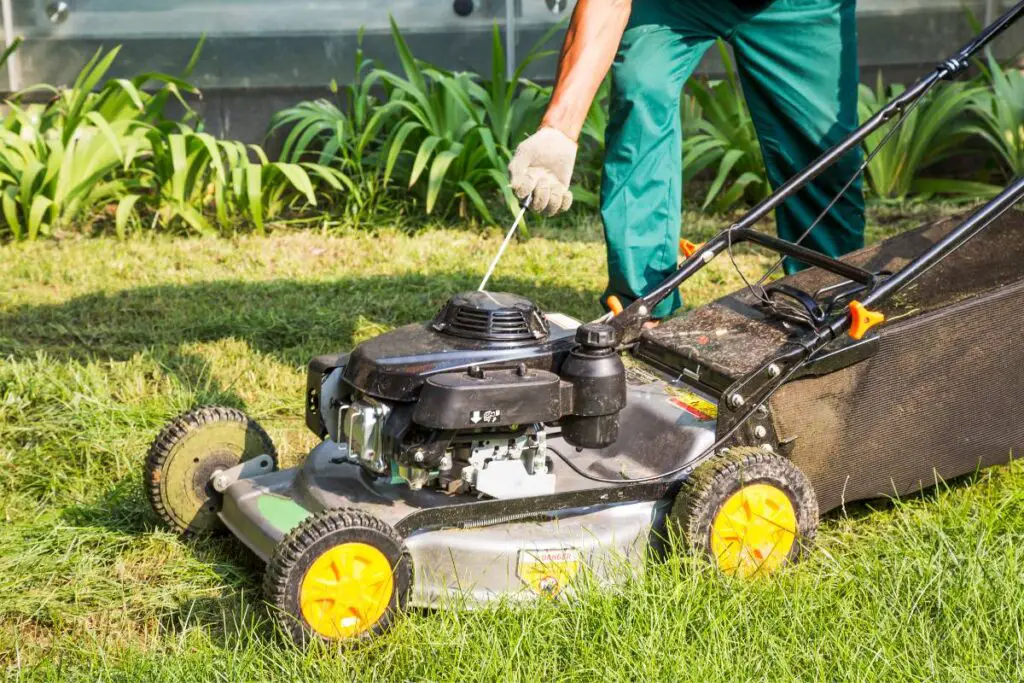
Importance of maintaining fuel for lawnmowers
In a lawnmower, fuel is essential as the engine receives its energy from the fuel.
Usually, the fuel tank is the mower should be emptied before the storage.
But many people either forget to don’t bother doing it.
As a result, the moisture in the fuel evaporates, and only the sticky fuel residue stays.
It will further create issues in the mower’s performance by blocking the air filters, fuel lines, fuel filters, carburetors, and other internal parts.
Maintaining the fuel inside the lawnmower will prevent these blockages, keep the gas fresh and stable, and make it usable for the next mowing session.
But how do you take care of it?
The fuels start breaking down after 30 days of purchase and become unstable.
Adding some fuel additives or stabilizers will stabilize the fuel and increase its shelf life before the breakdown.
Besides, avoid ethanol-based fuel as it attracts too much moisture and corrodes the engine’s metal parts.
Use an ethanol-free fuel or one with less than 10% of ethanol.
Symptoms of harmful or old gas in a lawnmower
Degraded gasoline does not promote efficient combustion anymore.
Over time, it will deteriorate and give rise to several issues in the mower’s functionality.
The lawnmowers with harmful or old gas are tough to start, run poorly, lose power, and stall repeatedly.
The primary symptoms that conclude that your mower has terrible or old gas are as follows:
The lawnmower is hard to start
Old gas becomes terrible, making it hard to start the mower.
You have to crank the engine multiple times before you notice a splutter.
Old degraded gas will have less flammability, which makes it difficult for the spark plug to ignite the engine.
The engine is not running correctly
Even if you start your mower after a few cranks in the engine, it won’t work up to the mark.
The engine’s revs will constantly increase and decrease, be it in use or sitting idle.
Lawnmower stalling
A stalling lawnmower is another common reason.
The engine will begin to stall if there is no proper or adequate fuel for combustion.
So, it will keep stalling whenever you try to start the engine.
Gas discoloration
When your lawnmower is not doing great, check the gas color.
When the gasoline breaks down, the oxidation process will begin.
It will start changing color to brown or amber and become cloudy.
Looking for gardening supplies? We have tested 100's of products before recommending them to you guys. Check out our best pick below:
| Image | Gardening Supplies | Best Price? |
|---|---|---|
 Top
Top Top
Top | Raised Garden Bed Kit | Check On Amazon |
 | XLUX Soil Moisture Meter, Plant Water Monitor, Soil Hygrometer Sensor for Gardening, Farming, Indoor and Outdoor Plants, No Batteries Required | No Results |
 Top
Top Top
Top | 82 Pcs Garden Tools Set and Extra Succulent Tools Set | Check On Amazon |
 | Joeys Garden Expandable Garden Hose with 8 Function Hose Nozzle, Lightweight Anti-Kink Flexible Garden Hoses, Extra Strength Fabric with Double Latex Core, (50 FT, Black) | No Results |
 Top
Top Top
Top | Dual Chamber Compost Tumbler | Check On Amazon |
 Top
Top Top
Top | Sunnyglade Plant Stakes | Check On Amazon |
 Top
Top Top
Top | Organic Cold Pressed Neem Seed Oil | Check On Amazon |
 Top
Top Top
Top | Mighty Mint Gallon :-Insect and Pest Control Peppermint Oil | Check On Amazon |
 Top
Top Top
Top | Scotts DiseaseEx Lawn Fungicide | Check On Amazon |
 Top
Top Top
Top | Jacks Classic 20-20-20 All Purpose Fertilizer | Check On Amazon |
 Top
Top Top
Top | 30,000 Seeds Pollinator Attracting Wildflower Mixture | Check On Amazon |
 Top
Top Top
Top | Survival Vegetable Seeds Garden Kit-Over 16,000 Seeds | Check On Amazon |
Gas smell
Try to smell the gas if you suspect it has become too old.
Old gasoline will have a sour smell different from fresh gasoline.
However, it is better not to sniff the gasoline too much for extra confirmation.
Gasoline has toxic chemicals like benzene and hydrocarbons; smelling it can be dangerous.
Why does old gas cause issues in the lawnmower?
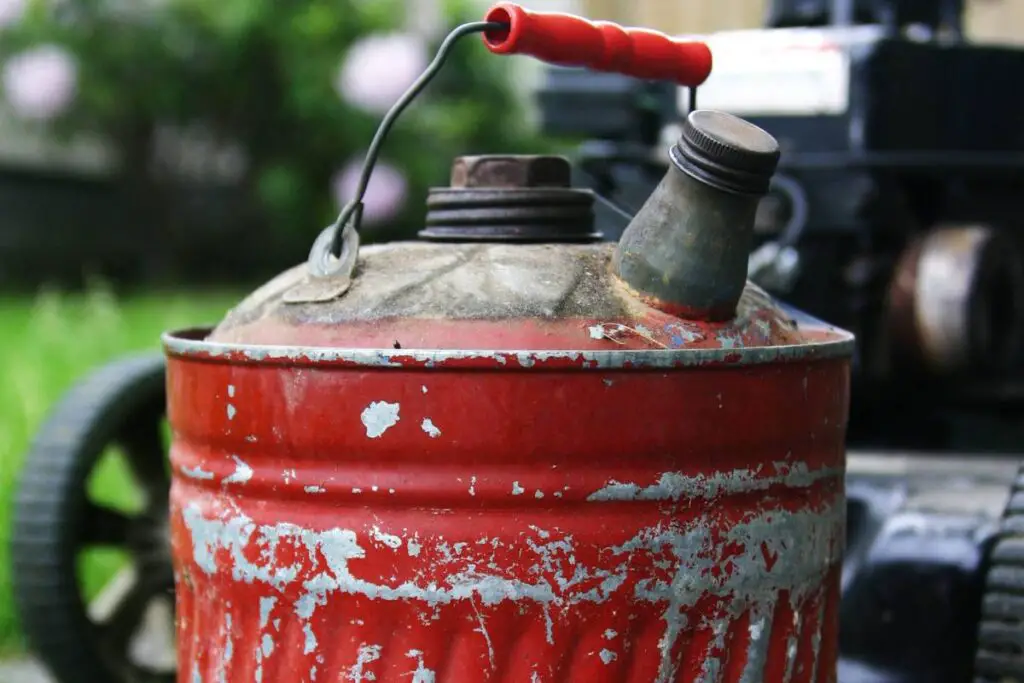
Gasoline contains a shelf life of about 3 to 6 months.
Gasoline is derived from oil that has existed for several years.
The refineries turn the rich crude oil into light gasoline by heating it in a furnace until it vaporizes.
It becomes suitable for use in lawnmower engines.
We all know that most house owners put their lawnmowers in storage during the cold months.
So, it is common to find issues in lawnmowers filled with gas without stabilizers.
Your mower may run with old gas, but it won’t work up to the mark.
But why does it happen?
Here’s what I found out.
Gasoline starts to break down after 30-60 days of purchase.
Over time, when the gasoline ages, it will evaporate and lose its essential elements.
Since the fuel no longer remains combustible, it won’t start the engine smoothly.
When the hydrocarbons in the fuel mixture evaporate, it leaves behind a fuel gum that is a thick and sticky byproduct.
It becomes tacky and varnish-like.
These residues can further clog the fuel lines, filters, pumps, and carburetors.
When the sticky gum reaches the engine parts, like the fuel filters and lines, they must be thoroughly cleaned or replaced.
The carburetors and the cylinder heads need to be overhauled.
E10 gasoline products make up 98% of fuel sold in the United States.
It means gasoline is hygroscopic (attracts moisture) and is a 10% ethanol-based product.
When the E10 fuel stays in your gasoline for extended periods, it will attract more moisture.
Over time, corrosion will occur within the engine’s metal parts, like the carburetors, cylinder heads, and pistons.
So, old gas can poorly damage the engine and its parts.
Therefore, emptying the fuel tank before storage or maintaining the remaining fuel by adding additives and stabilizers is essential.
The process of removing old gas from the mower
You must empty the fuel tank of the lawnmower before long-term storage.
For short-term storage, adding stabilizers will be enough.
Starting a mower with the old gas will make the lousy gas flow to the carburetor and create a mess that will take hours to correct.
I follow two ways to remove the gas from the lawnmower:
Process 1: Using a siphoning pump
Removing the old gas with a siphon pump creates a lesser mess.
But how you will siphon the fuel depends on the type of siphon pump you own.
Using automatic siphon pumps is the easiest way to remove the old fuel.
You can insert the pump into the fuel tank and flip the switch.
Manual siphon pumps require effort.
Here are the steps:
- Open the cap, insert the pump’s top hose, and submerge it in the tank. There will be two hoses: the top house will be from where the fuel will be drained, and the bottom hose will bring the drained fuel to the secondary container.
- Use a plastic container to store the fuel from the tank. Avoid metal containers, as the gas flow can generate static electricity and cause sparks.
- Pump the siphon with your hand, drain the fuel, and shift it to the plastic container.
- Remove jams and spirals from the siphon hose for faster drainage.
- Continue siphoning until the fuel tank is empty.
Process 2: Manually removing the gas
If you do not have a siphoning pump, remove the gas manually.
Here are the steps that I follow:
- Place a plastic container on the ground, take a hose, and try to reach the gas.
- While placing the hose inside the tank, blow into the hose and listen for bubbles. If you hear the bubbles, you have reached the gas. Place the first hose’s other end in the container.
- Place another hose slightly shorter than the first one on one end of the gas tank. The shorter hose doesn’t have to touch the gas.
- Blow into the end of the hose and add air to the tank. Increase the air pressure inside the tank.
- You will have to make multiple attempts to let the gas flow. So, be careful not to inhale the gas fumes.
- As you blow the air inside the hose into the tank, the gas will siphon out of the tank and fall into the container.
- The air pressure is essential here, but gravity will help this method work. So, keep the container over the ground.
6 Tips to Start a Lawnmower with the old gas
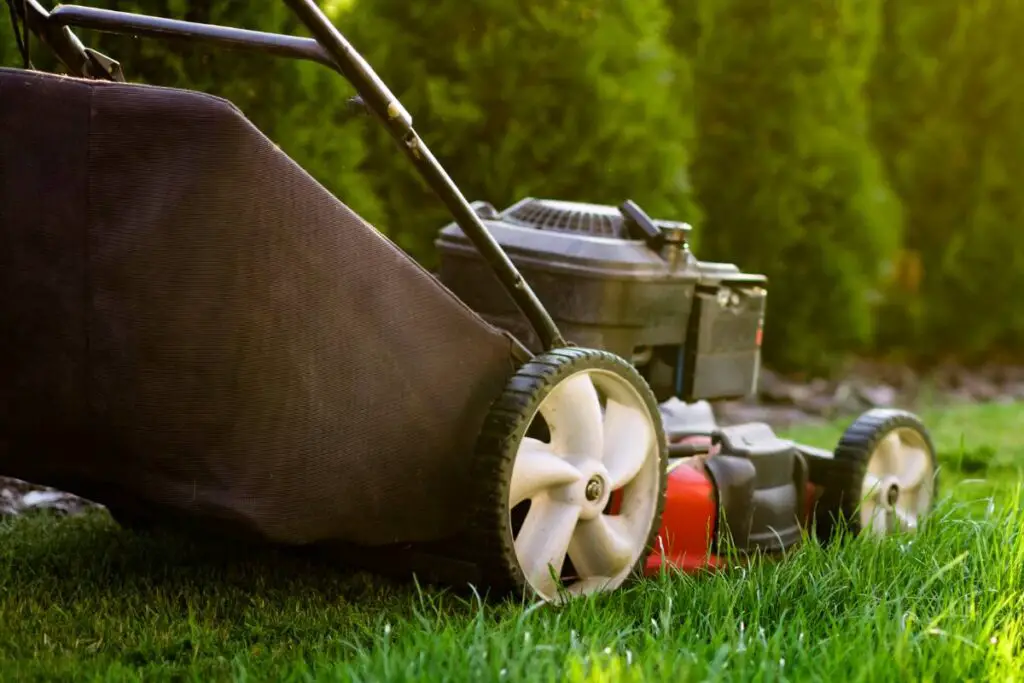
Experts recommend emptying the fuel tank before you store the lawnmower, especially during long-term storage.
But what would you do if you forgot to do it and remembered about it just before another mowing session?
Don’t worry; this section will cover tips for starting a lawnmower with old gas.
Generally, you do not start a mower with old gas in it.
To start a mower containing old gas, you should clear the tank and clean every part of the lawnmower suspected of getting affected by the old fuel.
So, below is a step-by-step tip or guide to clean those parts and start the mower anew.
1. Clean the tank
When your mower is filled with harmful gas, remove the gas and empty the tank.
It would be better to clean the tank before it gets enough time to sit for too long.
Because if that happens, cleaning becomes very difficult due to the fuel gum.
Most people don’t know about it.
You can either siphon the gas from the tank or take it out manually.
Read THE PROCESS OF REMOVING OLD GAS to know how to remove the gas properly.
Do not use water while cleaning the gas.
Once you have siphoned all the gas out, check the tank for any leftover residue before you fill it with new gas.
2. Check for clogged fuel filters
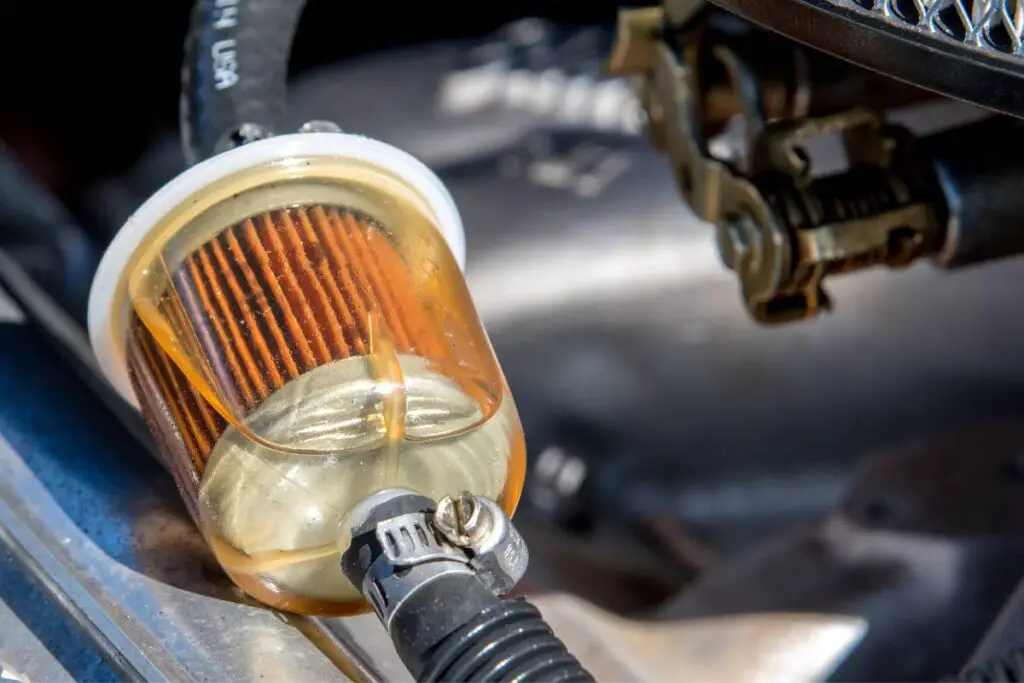
The old fuel gum can block the fuel filter if it sits in your mower for too long.
When the leftover deposits flow out of the tank, they won’t be able to pass through the fuel filters.
The filter will become clogged with sticky residue, and it will stop the fuel from flowing properly.
Replace the fuel filter with a new one by the following steps:
- Turn off the fuel supply by turning off the valve. If there is no valve, use pinch pliers to crimp the fuel line and stop the flow.
- Remove the clogged filter from the mower.
- Insert a new inline filter between the fuel lines.
- When you install the fuel filter, you will see an arrow on the housing side.
- While installing, insert the fuel filter to position the arrow toward the fuel flow.
Changing the filters annually can prevent several issues.
3. Check for clogged fuel lines
Old fuel can also leave sticky residues in the fuel lines when you mistakenly start the mower filled with old gas, which flows to the lines.
To check for a good flow, follow the following steps:
- Stop the mower’s fuel flow by stopping the fuel from flowing out of the tank. For that, turn the fuel shut-off valve at the tank’s bottom or under the seat of zero-turn mowers.
- If there is no shut-off valve, use pinch pliers to crimp the line and stop the flow.
- Locate the fuel line section to check and remove the line’s end furthest from the tank.
- Keep the fuel line in a container to collect the fuel.
- Start the fuel flow by turning on the valve or removing the pinch pliers.
- Check the flow of the fuel from the line. If the flow is good, your fuel line is clear; otherwise, it is blocked.
- Stop the fuel flow, remove the clogged line, and spray some carburetor cleaner into the line to loosen the blockage.
- Blow compressed air through the fuel line to remove the clogging. Repeat the process until the fuel line is clear.
- If cleaning is difficult, buy and reinstall a new fuel line with the same size and diameter.
4. Examine the carburetor
Check the carburetor once.
When the fuel leaves the tank, it reaches the carburetor.
Due to the stickiness, the carburetor can malfunction.
Old fuel can clog and freeze up in the small parts of the carburetor that need cleaning.
You can spray it by letting it stay in the mower, or you have to take it out from the mower for cleaning.
For spraying:
- Remove the air filter and spray some carb cleaner or aerosol into the air intake.
- Let the spray dry, and then turn on your engine.
My favorite carb cleaner is Gumout 8000002231 Carb and Choke Cleaner, 14 oz for a cleaner (Pack of 6). It works brilliantly.
You can try other options, too, if you want. But I love using it as it cleans perfectly.
For thorough cleaning:
- Remove the spark plug, the throttle, and the choke cables.
- Remove the filter housing and unscrew the nuts holding the carburetor.
- Open the springs from the carb and twist the carburetor.
- Carefully handle the gasket and make sure not to tear it.
- Unscrew the float bowl and detach it without hurting the O-ring.
- Use a wire to clean the carburetor’s center for clogged holes.
- If there are any white crusts, clean them with carb cleaners.
- Sink the carburetor in a container filled with coke and carb cleaner.
- After some time, remove the carburetor, let it dry, and reinstall it.
5. Check the spark plug
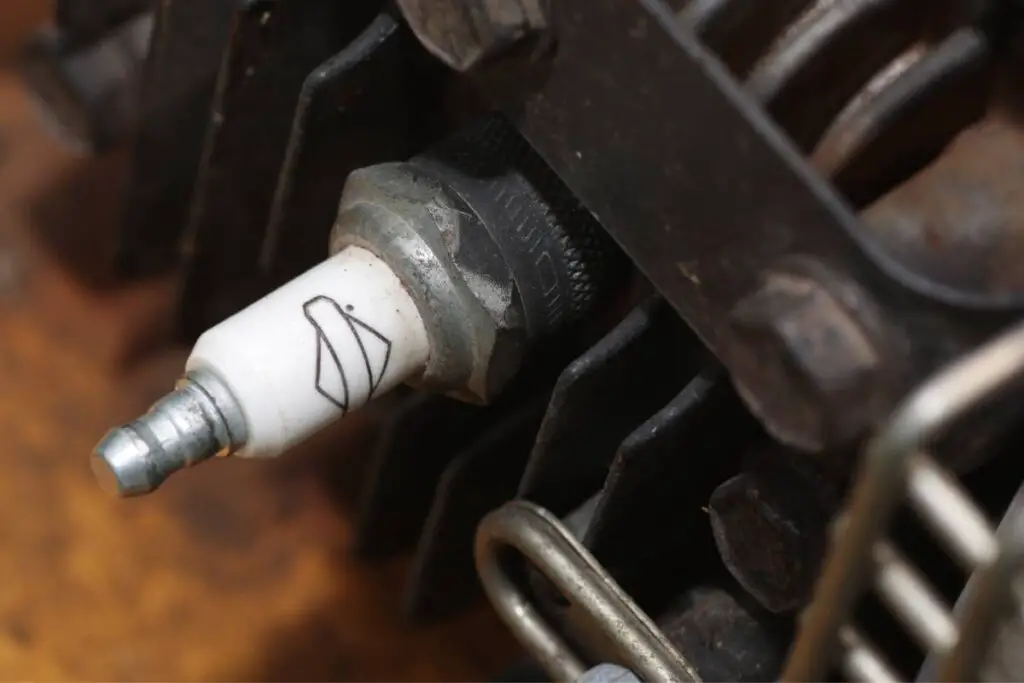
Now, it is time to check the spark plug.
Adding new gas, new filters, and clean fuel lines will almost make your mower as new.
But it won’t start if there is a problem with the spark plugs.
When you store the mower for a long time, the spark plugs can malfunction due to loose wiring. Check the wiring once and make sure the plug is clean.
Push the plug to ensure there is a firm connection.
Spark plugs should be changed after every 25 hours or every new season.
6. Use ethanol-free gas with stabilizers and additives
After you have completed every cleaning step for a mower with old gas, the last step is to fill the fuel tank.
I prefer filling the gas tank as the last tip because you may have to tilt or move the mower too much during the above cleaning processes.
Aggressive movements can cause gas leakage. So, it is better to fill the tank in the end.
Fill new fresh gasoline with a fuel additive mixed in to clean and remove the moisture from the fuel system.
Use Sea Foam Motor Treatment or STA-BIL Storage Fuel Stabilizer for the additive.
Mix the additive according to the instructions explained in the bottle level.
There are two types of stabilizers to use: one for performance and the other for storage. Ask the shop owner to give you the right.
Add 1 ounce of stabilizer or additives per gallon of fuel.
Use an unleaded fuel with 87% octane level and only 10% or less ethanol.
Ethanol-free gasoline is the best type of gas for a lawnmower.
Ethanol is moisture, and ethanol-based gasoline can attract moisture to a great extent and further create problems in the mower’s operation.
Start the mower engine and let it run for some time until it stops running sluggishly.
Some people do not add stabilizers to ethanol-free gasoline.
It has no problem, but I suggest adding stabilizers that improve gasoline performance.
How to safely dispose of old gas?
Once you have safely removed the old gas from the lawnmower, you must dispose of it properly.
To dispose of the old gas safely:
- Pour the gasoline collected from the mower into a government-approved container and seal it with a tight cap.
- Call the local waste management of your region for an ideal disposal site for such lousy gasoline.
- Throw the gasoline into the established disposal area.
What is the proper ratio of additives and stabilizers when adding to old gas?

Fuel stabilizers and additives will keep your mower’s leftover gas from breaking down when it ages.
Gasoline starts to break down after 30 days of purchase.
Adding stabilizers and additives can stop the gasoline from breaking down and keep it fresh for the next mowing season.
There is no exact ratio of stabilizers, additives, and gasoline.
It highly depends on the container size.
You can either have 5-gallon gas or one-gallon gas.
Generally, you must add 1 ounce of stabilizers and additives for every 1-2 gallons of gasoline.
Some people also follow the 2:1 ratio, i.e., 2 ounces of stabilizers added to one gallon of gasoline.
I have used the STA-BIL Storage Fuel Stabilizer for a long time. Sometimes, I use Sea Foam SF-16 Motor Treatment – 16 oz.
How to properly store gas for a lawnmower to prevent future issues?
Proper storage is essential, whether you empty the lawnmower tank and store it separately or let the gas stay in the mower’s fuel tank.
It would be better to add additives or stabilizers in both circumstances.
For short-term storage, you do not have to empty the lawnmower tank.
Add some stabilizers to the gasoline and store the lawnmower in a safe place.
For long-term storage, collect the gasoline from the lawnmower’s tank and transfer it to a metal or plastic container approved for gasoline storage.
Please fill at least 3/4th and store it in a well-ventilated place protected from open flames, sparks, and combustible or flammable materials.
Add fuel stabilizers to prevent it from breaking down and keep it stable and fresh for the next mowing session.
Do not leave gasoline unattended, as it is highly flammable.
That is why experts do not recommend storing it.
If you ever face accidents like fire or explosion, gasoline flames can be dangerous.
Additionally, small pinprick holes or finicky vent nozzles of the plastic containers can encourage the gas vapors to escape and build up around the storage area.
If you must store the gasoline separately or inside the mower, keep it somewhere outdoors, away from your living area.
Make sure not to store more than 25 gallons. However, it won’t be a problem because most lawnmower engines need only 5 gallons of fuel.
Preventive tips to avoid future problems with old gas in your lawnmower
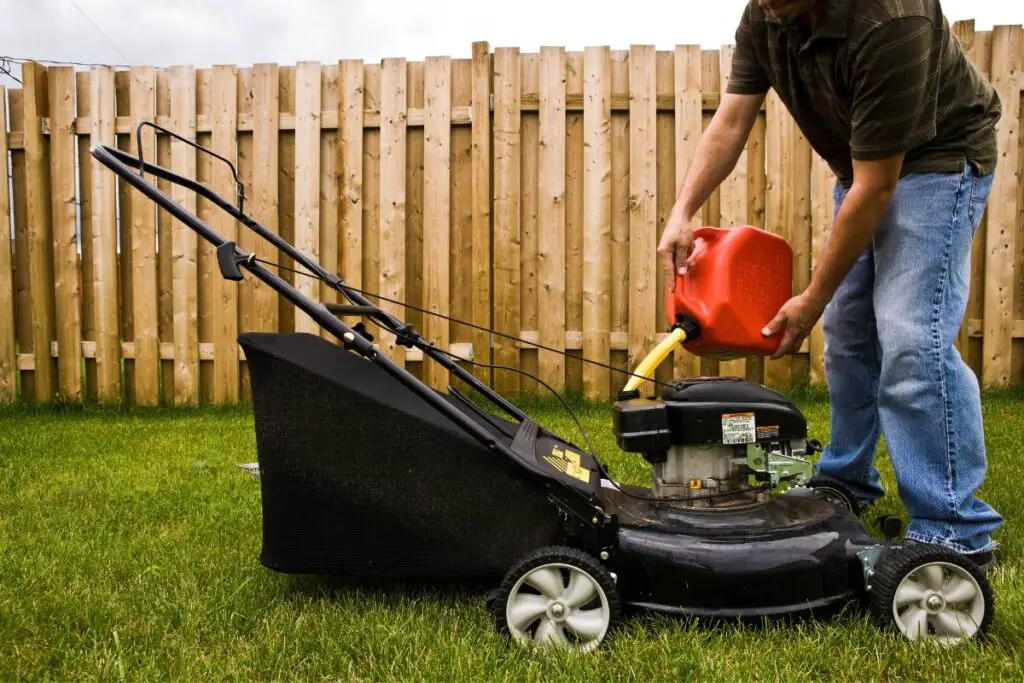
It is common for beginners to forget to empty the mower before storage.
So, if you are new here, I will suggest you some preventive tips to avoid future problems related to old gas in the mower:
- If you are storing the mower for a short term, you do not have to drain the gas. Instead, add some stabilizers to stop the gas from breaking down.
- If you are storing the mower for the long term, drain all the leftover gas and store it separately. Add stabilizers to increase its shelf life.
- Whenever you start mowing in the new season, use fresh gas.
- If there is little gas left, use it instead of storing it.
- Keep your mower clean and free from dirt and debris.
- Clean the carburetor annually with a carb cleaner.
- Change the fuel filters annually. Clean or replace the air filters every 3-4 months.
- Check the fuel lines for clogging and spray some carb cleaner to clean the blockage.
- Whenever you think of mowing after a break, check the oil first. If it feels fresh, you can begin with mowing. If it has degraded, follow the steps I shared for starting a mower with old gas.
Final Thoughts
Emptying the mower’s fuel tank after every mowing session ends is better. It will keep your mower clean and free from several issues. A mower filled with an old gas can lead to several issues like sputtering, stalling, constantly dying, losing power, and many more. It is because leaving the gas in the mower breaks down after 30-60 days.
The moisture will evaporate, and the sticky fuel gum will be left behind. Additionally, if the gasoline is ethanol-based, it will attract moisture and lead to corrosion in the engine’s metal parts. So, clear the tank before storing the mower for the long term. Leave the gas inside the tank for short-term storage and add stabilizers to prevent breakdown.
If you mistakenly left old gas in the mower, empty the tank and clean the fuel filters, lines, and carburetor. Then add ethanol-free gas with some fuel additives to start the mower again. Follow the preventive measures to prevent damages in your mower related to old fuel or fuel storage.
Can I mix old gas with new gas?
Do not mix old gas with new gas. Gas loses its combustion properties after 30-60 days of purchase. Adding this with new gas will not solve any issues, and you will keep facing old gas-related issues. Doing this will only waste the new gas.
What problems will the mower face with old gas?
With harmful and old gas, your mower will face issues like clogged fuel filters, lines, pumps, dirty carburetors, and blocked fuel caps. Altogether these issues won’t let your mower run smoothly. So, empty the tank or add stabilizers.
Reference: Lawnmower – Wikipedia
